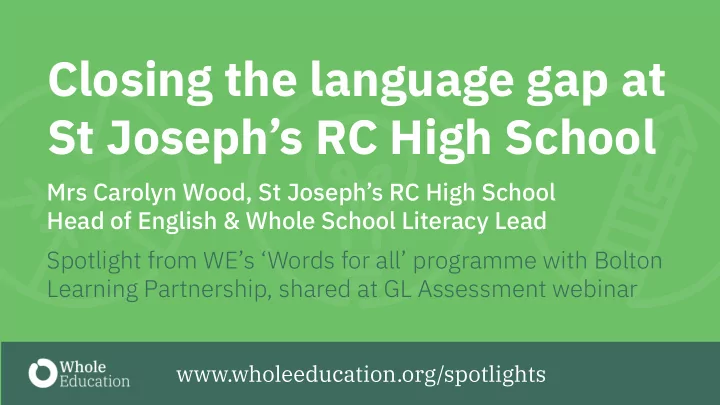

Closing the language gap at St Joseph’s RC High School Mrs Carolyn Wood, St Joseph’s RC High School Head of English & Whole School Literacy Lead Spotlight from WE’s ‘Words for all’ programme with Bolton Learning Partnership, shared at GL Assessment webinar www.wholeeducation.org/spotlights
Intent: aims and priorities. Why did we join ‘Words for All’? • Whole school priority – to secure a progress 8 score in line with or above the national average. Priority groups to target were PPG students and HPA boys. • Literacy needed to be used a vehicle to pave the way for sustainable change. To achieve this, it was essential to grow the presence of literacy across the curriculum. This would then allow literacy to become a tool to enhance culture capital. • Imperative that students could contextualise their learning. • Closing the vocabulary gap and improving outcomes in written components were key areas to address.
Implementation: How did I begin to achieve my intent? Create a ‘buy in’ from staff by visualising the ● advantages of literacy for all subject areas. Inspired and enlightened teachers in CPD to ● see the benefits of a consistent, holistic approach to literacy. Create bespoke strategies for subject areas ● to assist in increasing outcomes. Design and create a ‘tool kit ’ of strategies for ● staff to embed within schemes of learning. Encourage explicit vocabulary teaching - ● decoding the origins of words to enhance examination performance.
Implementation: improving comprehension. Understanding the term is the first step to understanding the skill. I improved comprehension, simplifying exam terminology to create a greater impact in assessment. ● Wall displays Classroom resources (laminated cards) ● Front of exercise books/ student planners ● During lessons ● Creating bespoke resources for subject areas has been a successful strategy in decoding exam terminology. Working closely with more vocational subjects helped to improve extended responses more rapidly which led to measurable gains quite quickly.
Impact: evidencing improved outcomes. PE example (before) • Lack of discourse markers • Under-developed explanations/bullet points • Unfocused, lack of clarity PE example (after) • More developed/ clearer explanations • Discourse markers
Impact: evidencing improved outcomes. Y10 DD2 Y10 DD3 Impact PE Progress 8 -1.66 -0.69 +0.97 Boys -2.17 -1.0 +1.17 PPG -1.85 -0.87 +0.98 9-5% 28.07% 40.0% +11.93% 9-4% 42.11% 67.27% +25.16%
Moving forward in year two… Tier two: Tier one: ● NGRTs highlighted the need to move ● Projected similar gains in D&T, from words to reading. ICT, and Drama. ● Results highlighted two sets of ● Create triads for sharing good intervention needed. Decoding issues in higher ability students were being practice with he aim of masked by their ability to comprehend reaching Science, Maths, large passages. These students often found word problems in maths an issue. Humanities and MFL. ● Other students could decode very well, ● Evaluate impact of decoding but reading comprehension was an issue. This would limit outcomes in methods. subjects that are largely text based e.g. humanities.
Recommend
More recommend